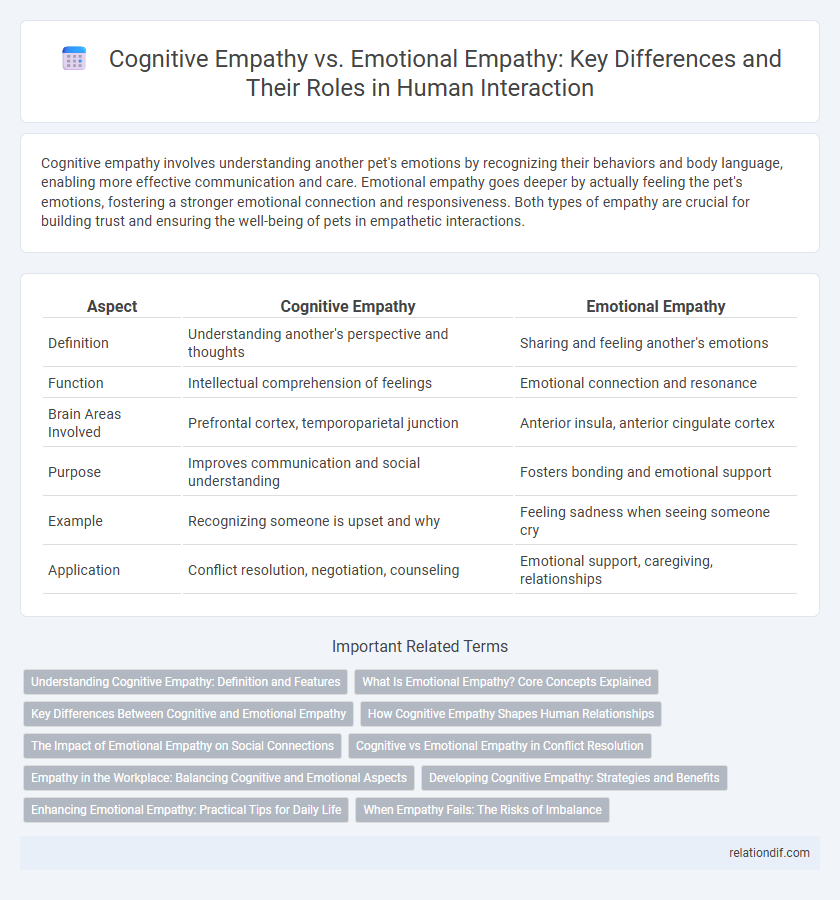Cognitive empathy involves understanding another pet's emotions by recognizing their behaviors and body language, enabling more effective communication and care. Emotional empathy goes deeper by actually feeling the pet's emotions, fostering a stronger emotional connection and responsiveness. Both types of empathy are crucial for building trust and ensuring the well-being of pets in empathetic interactions.
Table of Comparison
| Aspect | Cognitive Empathy | Emotional Empathy |
|---|---|---|
| Definition | Understanding another's perspective and thoughts | Sharing and feeling another's emotions |
| Function | Intellectual comprehension of feelings | Emotional connection and resonance |
| Brain Areas Involved | Prefrontal cortex, temporoparietal junction | Anterior insula, anterior cingulate cortex |
| Purpose | Improves communication and social understanding | Fosters bonding and emotional support |
| Example | Recognizing someone is upset and why | Feeling sadness when seeing someone cry |
| Application | Conflict resolution, negotiation, counseling | Emotional support, caregiving, relationships |
Understanding Cognitive Empathy: Definition and Features
Cognitive empathy refers to the ability to intellectually understand another person's thoughts and feelings without necessarily sharing their emotional experience. It involves perspective-taking and recognizing others' mental states, enabling effective communication and problem-solving. Key features include active listening, analytical thinking, and distinguishing between one's own emotions and those of others.
What Is Emotional Empathy? Core Concepts Explained
Emotional empathy involves directly feeling and sharing another person's emotions, enabling an intuitive connection with their experiences. It activates mirror neurons in the brain, which simulate others' feelings, leading to genuine emotional resonance rather than intellectual understanding. This form of empathy is critical for forming deep interpersonal bonds and responding compassionately to others' emotional states.
Key Differences Between Cognitive and Emotional Empathy
Cognitive empathy involves understanding another person's perspective and mental state without necessarily sharing their emotions, using theory of mind and analytical processes. Emotional empathy, by contrast, entails directly feeling and mirroring another individual's emotional experience, often triggering an automatic affective response. Key differences include cognitive empathy's reliance on intellectual interpretation versus emotional empathy's foundation in affective resonance, influencing social interactions and emotional support dynamics.
How Cognitive Empathy Shapes Human Relationships
Cognitive empathy enables individuals to understand others' thoughts and perspectives, fostering clearer communication and reducing conflicts in relationships. By accurately interpreting emotions without being overwhelmed, it enhances problem-solving and collaboration between people. This form of empathy supports more balanced and rational interactions, strengthening social bonds and trust.
The Impact of Emotional Empathy on Social Connections
Emotional empathy enhances social connections by allowing individuals to deeply share and resonate with others' feelings, fostering trust and stronger interpersonal bonds. This empathetic engagement activates brain regions like the anterior insula and anterior cingulate cortex, which improve emotional understanding and compassion. Unlike cognitive empathy, which involves intellectual perspective-taking, emotional empathy drives authentic social support and collaborative relationships through genuine emotional attunement.
Cognitive vs Emotional Empathy in Conflict Resolution
Cognitive empathy enables individuals to understand others' perspectives and thoughts during conflict resolution, promoting effective communication and problem-solving. Emotional empathy involves sharing or mirroring others' feelings, which can foster connection but also risk emotional overwhelm or bias. Balancing cognitive and emotional empathy allows for a nuanced approach, enhancing conflict resolution by aligning understanding with compassionate engagement.
Empathy in the Workplace: Balancing Cognitive and Emotional Aspects
Empathy in the workplace requires balancing cognitive empathy--the ability to understand colleagues' perspectives--and emotional empathy, which involves sharing and resonating with their feelings. Cognitive empathy fosters effective communication and problem-solving by enabling accurate interpretation of others' viewpoints without becoming emotionally overwhelmed. Emotional empathy enhances team cohesion and trust, promoting supportive work environments where employees feel valued and understood.
Developing Cognitive Empathy: Strategies and Benefits
Developing cognitive empathy involves actively enhancing perspective-taking skills through practices such as active listening, mindfulness, and engaging with diverse viewpoints. These strategies improve social interactions by enabling individuals to understand others' mental states more accurately, fostering effective communication and conflict resolution. The benefits of cognitive empathy include increased emotional regulation, improved problem-solving abilities, and strengthened interpersonal relationships in both personal and professional settings.
Enhancing Emotional Empathy: Practical Tips for Daily Life
Enhancing emotional empathy involves actively tuning into others' feelings through mindful listening and nonverbal cues such as facial expressions and tone of voice. Practicing perspective-taking exercises, like imagining oneself in another's situation, strengthens the emotional connection beyond the intellectual understanding characteristic of cognitive empathy. Daily habits such as journaling emotional reactions and engaging in empathetic conversations foster deeper emotional resonance and compassion.
When Empathy Fails: The Risks of Imbalance
Cognitive empathy involves understanding another person's perspective, while emotional empathy is the capacity to share and feel their emotions. When these two forms of empathy are imbalanced, cognitive empathy without emotional connection can lead to detached or manipulative behavior, whereas excessive emotional empathy may cause burnout or enmeshment. Maintaining a balance is crucial for effective interpersonal relationships and psychological well-being.
Cognitive empathy vs emotional empathy Infographic

 relationdif.com
relationdif.com